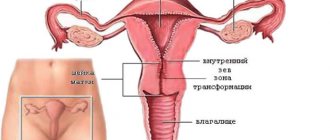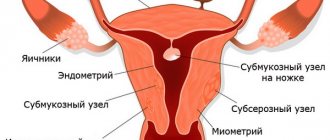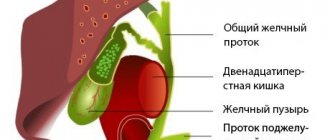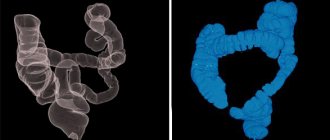What is a pessary?
Prolapse and prolapse of the pelvic organs in women is a common occurrence.
In medical practice, this disease is called prolapse. This term defines the prolapse of small organs (uterus, vagina, bladder), with their subsequent prolapse outward. The pathology can affect not only older women, but also quite young women. This condition is not life-threatening, but significantly affects its quality. This causes excruciating pain for women and can also result in urinary incontinence, kidney failure, etc.
Even in the time of Hippocrates, pomegranate was used as a pessary, which was previously soaked in vinegar. Over time, the choice of different materials became much larger; people began to use wood, cork, and then rubber to make them.
Today, gynecological pessaries are made of polypropylene and silicone. Time has changed not only the material, but also the very type of this device, which allows you to choose exactly what will suit the female problem as best as possible.
The device consists of rings of different sizes connected to each other. For each woman, the doctor will select exactly the size that suits her.
Dr. Arabin's pessaries
The gynecological pessary "Arabin" is manufactured using the most modern technologies. All materials used have hypoallergenic properties, softness and good flexibility. The gynecological pessary “Doctor Arabin” has a low cost, which allows any woman to purchase this product. There are almost no contraindications for use.
But you should remember: before buying any pessary, you need to consult a doctor to avoid negative consequences.
Prolapse and prolapse of the vagina and uterus is a pathology that causes considerable discomfort to a woman, negatively affecting the quality of life. In medicine, the disease is called genital prolapse, and for a long time the only method of treatment was surgery - a traumatic and ineffective technique.
Patients who refuse surgery are offered a pessary. The main goal of the procedure is to maintain the uterus in case of atrophy of the pelvic floor muscles, diaphragm and anterior abdominal wall. Insertion of an obstetric pessary is an alternative therapy if surgery is not possible.
Causes of prolapse of internal genitourinary organs in women
Prolapse is diagnosed when the abdominal and pelvic muscles relax. This happens due to abdominal pressure, in which the ligaments lose their elasticity and become unable to support the uterus, vagina and bladder.
For this reason, the muscle tone of the perineum decreases and prolapse occurs.
In older women, the muscles that support the uterus and maintain the normal position of the vaginal walls stretch and the genitals descend, sometimes completely falling out through the genital opening.
Also, prolapse and premature dilatation of the uterus can be observed in women during the period of carrying multiple pregnancies and with uterine tone.
Factors influencing the development of genital prolapse in women most often include:
- Long and difficult labor, with varying degrees of trauma. It should be noted that complicated childbirth causes prolapse in almost half of the patients.
- Connective tissue problems.
- A decrease in sex hormones, especially during menopause.
- Pathologies of a chronic nature, which are accompanied by high intra-abdominal pressure (severe cough with bronchial asthma, regular constipation, etc.)
- Disruptions in the circulation of blood and lymph in the pelvic organs.
- Reduced physical activity.
- Too much weight or sudden weight loss.
- Certain oncological diseases of the reproductive system.
- Regular, heavy physical activity.
- Hereditary factor.
- Some female surgeries and surgical interventions on nearby organs.
Main types, shapes and sizes of pessaries
Pessaries or uterine rings are flexible silicone medical products that are designed to create additional support, fix the organ when it is displaced, and also act as a barrier to prevent prolapse of the uterus, rectum, bladder or sagging of the vaginal walls.
Due to its elasticity, this device, after being inserted inside, easily takes the desired position and does not at all affect the woman’s freedom of movement and her usual rhythm of life. Rings vary in shape and size:
- thin;
- curved (Hodge pessaries);
- mushroom-shaped;
- cup regular or perforated;
- tandem;
- urethral;
- calyx-urethral;
- cubic;
- adaptive.
The diameters of the pessaries are also uneven and vary from a minimum of 50 mm to a maximum of 100 mm. Moreover, according to the type of appointment they distinguish:
- Obstetric rings. Indicated for pregnant women to avoid the threat of premature birth and for the prevention of ICI (isthmic-cervical insufficiency).
- Gynecological rings. Used for prolapse/prolapse of the uterus and organs of the female reproductive system.
Determining and selecting the desired type and size of pessary is exclusively a medical prerogative.
However, it is important to distinguish between vaginal and uterine rings. The former act as a barrier method of contraception, while uterine rings are a therapeutic and prophylactic device. You can buy the necessary pessary in pharmacies or medical equipment stores, but only after consulting a gynecologist.
Advantages:
- Effective therapy for uterine prolapse.
- Help in maintaining pregnancy and preventing the risk of premature birth.
- High effectiveness at any stage of pregnancy and with varying degrees of uterine prolapse.
- Hypoallergenic.
- Safety and ease of use.
- There is absolutely no risk of soft tissue injury.
- A good alternative to surgical treatment (various types of operations are discussed at the link).
Types of pelvic organ prolapse in women
Anterior prolapse includes:
- Urethrocele (the anterior wall of the vagina and urethra descends)
- Cystocele (parallel prolapse of the anterior wall of the vagina and bladder is diagnosed)
- Cystourethrocele (combines two previous pathologies)
The above types of prolapse are characterized by difficulties with urination, the development of cystitis and infectious pathologies of the urinary system. In this case, the uterus is in the correct position.
This occurs due to the muscle-ligamentous apparatus not holding the bladder and vagina. The urethra or bladder descends to the front of the vagina, lowering it down to the genital opening.
In a critical situation, the bladder falls out with the vaginal wall completely outward. Basically, this type of prolapse accompanies women during menopause; there is also a high risk of its development in women with difficult childbirth, which was accompanied by severe ruptures and injuries.
Currently, there is a whole classification of these gynecological devices.
Supportive - designed to support the uterus, preventing it from prolapse. These include:
- gynecological pessary with an elevator, which is used in the treatment of incontinence;
- thin uterine rings;
- thick rings;
- cup-shaped;
- made in the form of stripes.
Fillers are designed to prevent the walls of the uterus from sagging. They prevent prolapse of the rectum and bladder. This type includes:
- thick rings;
- mushroom-shaped inflatable pessaries;
- cubic devices.
MORE ABOUT: Treatment of cervical cancer with burdock leaf juice
But, as with any treatment method, the use of a pessary has its contraindications. Doctors do not recommend installing a pessary in the following cases:
- with bleeding;
- in the presence of infectious diseases;
- in case of detection of inflammatory processes in the uterine area;
- narrow vaginal passage;
- as a result, the identification of precancerous diseases.
Installing a gynecological pessary for constant wear is not recommended for those who, due to certain circumstances, cannot visit a specialist once every six months, as well as for very loving women.
A pessary is a kind of ring that is made of high-quality silicone or polypropylene.
- Supportive, it does not allow the vagina to sag, it supports it.
- A thin ring is fixed directly on the cervix.
- Thick ring.
- A cup-shaped pessary with a special perforation is used to remove the secretion of the gonads.
- Cubic device type.
- The filling ring prevents the process of uterine prolapse.
- Mushroom type.
Which type is better
The choice of a ring for the vagina should be made by a physician; the size and shape must fully correspond to the anatomical features of the vagina, so only the attending physician can evaluate all these factors.
The supporting type is recommended for use for prolapse of the second or third degree. Using a ring-type device for severe prolapse can lead to compression of the uterus.
For the fourth degree of prolapse, it is better to use a cup-shaped device; it is used with a levator if the patient, among other things, also has urinary incontinence.
You should know that this device comes in different forms, some can be worn constantly, and some should be removed daily and the genitals treated.
It is very difficult to master the correct use and insertion of this device on your own, and if you do not have experience, it is recommended that you visit your doctor as often as possible, who will clean the genital tract himself.
In general, the use of this method of treatment is considered convenient and safe, with it women can lead a full life. Due to its unsurpassed versatility, this method of therapy solves many gynecological problems in women.
Gynecological
This is the second large group of medical products for older gynecological patients. This is a very extensive group of uterine and cervical rings, vaginal pessaries for the correction of various types of prolapse or prolapse of the female genital organs:
- Prolapse of the vaginal walls of various degrees.
- Rectocele and cystocele.
- Elongation or pathological lengthening of the cervix.
- Complete prolapse of the uterus.
All these conditions are often observed in older women, especially in risk groups:
- Multiparous women;
- Women with complicated childbirth, birth injuries of the vagina and cervix, birth of a large fetus.
- Women with heavy physical work involving heavy lifting.
- Patients with a genetic predisposition - for example, connective tissue dysplasia syndrome.
Pelvic organ prolapse causes a woman not only physical inconvenience, such as disturbances in urination, urine outflow, difficulty defecating, pain in the lower abdomen, abrasion and ulcers of the delicate mucous membranes of the vagina and cervix, but also mental discomfort and huge complexes in sexual life.
It is very important to understand that pessaries and uterine rings are only a palliative or temporary option. The best option for correcting pelvic organ prolapse is surgical treatment - pelvic floor plastic surgery in various ways.
A pessary for uterine prolapse and other pelvic organ prolapses in young and middle-aged women can be used only temporarily - at the stage of preparation for surgical treatment.
Unfortunately, situations arise in life when surgical treatment is impossible or is postponed due to the patient’s health. It often happens that in older women surgery is not possible at all. It is they who have to use the ring for prolapse of the uterus and vaginal walls for life.
The required model and size of the pessary for gynecological patients with pelvic organ prolapse is also selected by the doctor after examining the patient. The doctor takes smears, including a required cytological smear or smear for cancer cells from the cervix.
Unlike pregnant women, in gynecological patients it is preferable not to constantly wear a gynecological ring to support the uterus, but to periodically remove it, treat it and reinsert it.
It is ideal to remove the pessary at night, rinse it, treat it with an antiseptic and reinsert it in the morning. The maximum possible period of stay of the pessary in the vagina is 7 days, subject to periodic preventive administration of sanitary suppositories.
Application
If an obstetric pessary is inserted into a pregnant woman only by a doctor and the ring remains there for the entire required period, then for pelvic organ prolapse the tactics are different. To prevent bedsores and infections, it is advisable to remove the pessary daily. That is why gynecological patients are interested in learning how to independently remove and insert pessaries, so as not to go to the doctor several times a week.
Let us remind you that the maximum time a pessary can remain in the vagina is 7 days, provided that twice a week the patient places suppositories in the vagina for sanitation.
The first administration is carried out by a gynecologist. The doctor must show the patient the device of the pessary and explain in detail the sequence of actions during its insertion and subsequent removal. In the future, the patient can try inserting a pessary at home.
Let's look at how to insert a uterine ring at home:
- Before insertion, you need to toilet the external genitalia and wash your hands with soap.
- It is most convenient to insert the pessary in three positions: lying on your back with bent legs, squatting, or throwing your leg over the side of the bathtub or stool.
- As a lubricant and an additional antimicrobial effect, you can use ointments or creams based on antiseptics or antimicrobial agents - synthomycin ointment, levomekol, Argosulfan, and so on. Ointment or cream is thickly applied to the ring.
- Next, the pessary is slightly deformed in the hands, as if squeezing it from the sides. The compressed ring is held with the right hand, and the labia are parted with the left. The compressed ring is quickly inserted into the vagina as deeply as possible - there it will straighten out and stand up on its own. If the uterus completely extends beyond the genital slit, it must first be reduced.
To control the correctness and reliability of the insertion, you can stand up and push - if the ring and genitals do not fall out, everything is done correctly. A correctly selected and inserted ring should not cause pain, discomfort or interfere with urination or bowel movements.
Since it is advisable to take out the ring every evening, the patient should also learn the rules for removing it. This is a simpler procedure. If you looked at the photos of pessaries and uterine rings, you should have noticed that almost every model has a hole. It is designed for fixation on the cervix and the outflow of vaginal secretions, but it is also very convenient to remove the pessary:
- They also perform toileting of the external genitalia and wash their hands.
- The ring is also easy to remove while squatting. You need to sit down and push slightly, insert your index finger into the vagina and find the ring itself and its hole there.
- The finger is inserted into the hole, and continuing to push, it is removed out.
Some rarer models of pessaries have a “tail” specially designed for removal - in this case, it is enough to squat down, push and pull the “tail”.
The removed pessary is washed with warm water and soap. It is advisable to leave the product overnight in an antiseptic solution, for example, chlorhexidine or miramistin, or treat it once with a stronger antiseptic solution. Carefully read the product processing recommendations on the packaging so as not to destroy the product or shorten its service life.
If you were unable to insert or remove the pessary yourself, wearing it gives you discomfort, or you do not fully understand the operating instructions, do not hesitate to contact a gynecologist for a “master class”.
Reviews of women who used the uterine ring
Medicine offers two main therapeutic methods for eliminating pelvic organ prolapse:
- Conservative.
- Operational.
Surgical intervention is indicated for severe forms. It represents various types of operations in which one’s own tissues are used, as well as various synthetic meshes.
Although operations are considered an effective option in this case, they are often fraught with complications and relapse of the disease.
Conservative therapy excludes the use of any medications or traditional medicine recipes, since there are no folk remedies or medications to eliminate this cause.
With conservative treatment, it is recommended to change lifestyle, that is, reduce physical activity, remove extra pounds, take preventive measures to eliminate constipation, etc.
Also an element of this treatment is special physical education, which helps to train the pelvic floor muscles. In addition, an integral part of the conservative method is the wearing of certain bandages and pessaries.
Installation of a pessary
The primary insertion of the uterine ring is carried out exclusively by a gynecologist in an outpatient setting. In the future, the woman, with the help of simple manipulations, can carry out this procedure independently. Its installation is always preceded by an individual examination for infectious and bacteriological inflammation.
The pessary is always inserted in the supine position. During this process, the ring is compressed and inserted deep into the vagina so that, when unrolled, the convex surface of the pessary faces the cervix. During and after this procedure, provided that the shape and size of the ring is selected correctly, the woman should not experience any painful or uncomfortable sensations.
Further, every two weeks for 1.5 months, an examination by a gynecologist is required to ensure the normal position of the device and the absence of the development of possible associated complications. The average period of wearing the ring is from 2 to 6 months, depending on the history of prolapse. If the pessary is not intended to be worn continuously, it must be treated with an antiseptic before each subsequent insertion.
How is a gynecological pessary installed and removed during pregnancy?
There is no difficulty in installing the device. It can be carried out not only in a hospital, but also on an outpatient basis.
Pregnant women tolerate this procedure very well. In cases where a woman has very low or high sensitivity of the uterus, doctors recommend taking a No-shpa tablet an hour before the procedure.
The entire manipulation does not take much time and is performed only on an empty bladder. The gynecological pessary itself is treated with gel and then inserted into the woman’s vagina.
After installation, they are performed every three weeks in order to prevent infection.
A pessary is not installed if the pregnant woman experiences bleeding in the second or third trimester. Installation is also contraindicated in the presence of various inflammatory processes.
The doctor removes the pessary at 36 weeks, but there are cases when this is done a little earlier.
Pessaries "Juno"
The material from which the gynecological pessary “Juno” is made meets all international standards. The ability of the plastic used to soften even at body temperature allows a woman to use it without assistance. It can be removed or installed at any time, allowing for the necessary treatment of the vagina.
The Juno pessary will provide the necessary support for the internal organs of the pelvis. Before installation, it is necessary to exclude the presence of inflammatory processes and precancerous diseases, as well as infections. The pessary is shaped like a small saucer with a hole in the center. Pre-lubricated with Vaseline, it is inserted into the vagina and turned over with the convex side towards the cervix.
Advantages of this treatment method
Like any treatment, using a device has its pros and cons.
- Effective therapy of the disease.
- Prevents premature birth and helps maintain pregnancy.
- For any degree of uterine prolapse, this device helps a lot, and patient reviews confirm this.
- Does not cause allergies.
- Safe method.
- An excellent alternative to surgery.
- There is absolutely no risk of damage to the uterine cavity.
MORE ABOUT: Eye drops for conjunctivitis with antibiotic
Minuses
- Used as an additional treatment for prolapse.
- Causes an unpleasant feeling of discomfort.
- Bacterial vaginosis can develop, but this does not always happen.
- The discharge increases.
- It may fall out due to improper installation.
Complications
As with any medical procedure, there are side effects and unpleasant consequences.
- The addition of a secondary infection due to a foreign body is the most common complication when wearing a pessary.
- Discomfort and pain when wearing a pessary - this side effect occurs when the size is incorrectly selected, incorrectly inserted or displaced.
- The pessary falls out - this also happens when there is an error with the size or incorrect insertion.
- Allergic reaction to the pessary material - as a rule, modern materials of the uterine ring are inert and do not cause allergies, but such rare complications are possible.
- The formation of bedsores is a common complication for elderly patients.
Women in menopause have very thin, vulnerable mucous membranes of the vagina and cervix, which are easily injured by a foreign body. Bedsores from the uterine ring are formed due to prolonged compression of the vaginal walls or cervix by an incorrectly selected or worn too long ring.
Pros and cons of using pessaries
Rings are used for uterine prolapse due to their following advantages:
- Possibility of fixing the organ without surgery;
- Efficiency in correcting deficiencies at different stages of development;
- No possibility of injury to the genital organs;
- Ease of use with the correct shape and size of the product.
There are several reasons why doctors recommend using uterine rings:
- Firm refusal to carry out operations.
- The need for treatment of the genital organs before surgery.
- Prolapse or prolapse of the uterus.
- Diagnosis of hidden urinary incontinence.
- If necessary, monitor the results of postoperative treatment.
- An effective way to maintain pregnancy.
uterine rings for uterine prolapse
The use of a uterine ring is contraindicated in women prone to allergic reactions or who have a reaction to the constituent components of the ring. In addition to allergies, the pessary is not recommended for the following diseases:
- abnormal development of the genital organs;
- cervical erosion;
- colpitis;
- inflammation of the cervix;
- neoplasms in the pelvis;
- bleeding of unknown etiology;
- acute infectious diseases.
What does the uterine ring (pessary) look like?
Gynecological or uterine rings (pessary for prolapsed uterus) help keep the body of the uterus in its natural place. Silicone or latex devices are inserted into the vagina by a doctor in a clinic setting. Thanks to their elastic and elastic structure, they secure the organ in the right place and prevent it from moving. The manufacturing material has a number of undeniable advantages. It is safe and hypoallergenic. A medical device, as a rule, does not cause discomfort, helps normalize vital activity, and does not interfere with the usual course of life. The mobility of the uterine pessary is ensured by the flexibility of the material, due to which, when it gets inside the vagina, it easily takes the shape and desired position.
How does the procedure work?
Prolapse or prolapse of the uterine body is a pathology typical for patients over 45 years of age who have had multiple births. The cause of the disease is weakening of the muscles of the anterior abdominal wall and pelvis.
- Narrow entrance to the vagina.
- Uterine bleeding, the cause of which has not been established.
- Infectious pathologies.
- Inflammatory diseases.
- Precancerous pathologies of the cervix.
Note: contraindications associated with the development of infectious and inflammatory processes and bleeding can be quite easily eliminated and a uterine ring can be installed in the future.
A permanent uterine ring is not installed in patients who cannot regularly visit a specialist (every three months), and in women who lead an active intimate life and do not know the algorithm for inserting a pessary.
Before insertion of the uterine ring, it is necessary to be tested for infections. Then the device and genitals are disinfected. Special ointments containing estriol, approved in gynecology, are used as a disinfectant. The ointment has a complex effect:
- facilitates insertion of the device;
- activates blood circulation in the vagina;
- normalizes regenerative processes in a woman’s body;
- prevents the development of infections.
The gynecologist performs the following manipulations:
- the patient is on a gynecological chair or on a couch in a supine position;
- the doctor returns the organs to the correct position;
- the pessary is inserted into the vagina in a compressed form;
- the device is placed so that the cervix is in the center of the pessary.
The procedure lasts one to two minutes and does not cause pain. After inserting the pessary, the gynecologist must ensure that the device is installed correctly and does not cause discomfort.
The ring should not fall out while straining. If the listed symptoms are observed, this means that it is necessary to select a pessary of a different size or shape.
The first insertion and removal of the device should be carried out exclusively in a gynecological office, under the supervision of a doctor. Then, for a month and a half, the woman should visit a specialist once a week for a preventive examination and treatment of the pessary and genitals.
The device is recognized as safe; after insertion, it does not interfere with the patient’s normal functioning. This is an effective method of treating prolapse, but if the recommendations are not followed, there may be a risk of inflammation of the urinary canal and vaginal walls.
To avoid such troubles, it is better to carry out the procedure under the supervision of an experienced, qualified gynecologist.
The first installation is carried out by a gynecologist in an outpatient clinic. Then the woman must learn how to install it herself.
Before this, it is necessary to undergo a full examination for possible detection of inflammatory processes or infectious diseases. Before introducing this item, it is sterilized or rinsed in boiling water.
For easier administration, Vaseline is usually used.
The device is inserted in a horizontal position, during this process it is compressed and installed as deep as possible in the vagina so that the convex part is turned towards the cervix.
During this manipulation, if the ring is correctly selected and installed for the patient, the woman should not feel pain or discomfort.
Naturally, you need to get used to everything and at first there will be a feeling of a foreign object in the body, but then the girl will not remember this element at all.
After installing this element, the girl must visit a gynecologist every two weeks for two months. This is necessary so that the doctor makes sure that this device is in a normal position and that it will not lead to other complications.
The average period of use of the ring is approximately six months, but it all depends on the stage of prolapse. If the device is not intended for permanent use, then it must be treated with an antiseptic before each insertion into the vagina; this is very important.
One way or another, if you have a disease such as prolapse, you should definitely try the rings first, and then if they do not help you, then it is recommended to have surgery.
In any case, such a disease cannot be ignored. Reviews from patients using this method of therapy indicate that the treatment gives excellent results.
If you do not deal with this problem, it can lead to other irreparable consequences, so it is recommended to undergo timely therapy and tests.
And if possible, get tested and visit a gynecologist every six months to identify the disease at an early stage and prevent its further development.
Every woman must give birth, and with a disease such as prolapse, the chances of pregnancy are reduced to zero. Doctors around the world claim that this method of therapy can increase the chances of being able to safely carry and give birth to a child.
Indications for installation of the uterine ring
When pathology is diagnosed in young patients, the most effective treatment method is surgery. In old age, surgery is not always acceptable. Doctors attribute this to a number of reasons:
- more natural aging of the body;
- presence of chronic diseases.
With the advent of modern technologies and the use of innovative materials, this technique is becoming in demand.
Installation of the uterine ring is prescribed in the following pathological situations:
- prolapse and prolapse of the uterus and vagina at the same time;
- urinary incontinence;
- contraindications to surgical therapy;
- the presence of concomitant pathologies, gynecological diseases, the treatment of which is carried out before surgery;
- the patient's refusal to undergo surgery;
- the need to predict the results of a surgical treatment method - the introduction of a pessary will help demonstrate the effectiveness and possible consequences;
- to detect urinary incontinence complicated by prolapse;
- isthmic-cervical insufficiency during pregnancy, which provokes the opening of the cervix and cervical canal - this situation threatens the life of the child.
- Narrow entrance to the vagina.
- Uterine bleeding, the cause of which has not been established.
- Infectious pathologies.
- Inflammatory diseases.
- Precancerous pathologies of the cervix.
Note: contraindications associated with the development of infectious and inflammatory processes and bleeding can be quite easily eliminated and a uterine ring can be installed in the future. A permanent uterine ring is not installed in patients who cannot regularly visit a specialist (every three months), and in women who lead an active intimate life and do not know the algorithm for inserting a pessary.
- The woman categorically refuses to undergo the operation.
- The patient consented to surgical intervention, but before the procedure it is necessary to treat existing diseases of the genital organs.
- Hidden enuresis was revealed.
- It is necessary to maintain the pregnancy.
A pessary for uterine prolapse is contraindicated in the following cases:
- The woman is allergic to the materials from which the pessary is made.
- There are deviations in the development of the reproductive organs.
- The inflammatory process (vaginitis), caused by infections, injuries and disruptions in endocrine and metabolic processes, progresses in the vagina.
- Bleeding for unknown reasons.
- Inflammation of the uterine cervix.
- Tumors in the pelvic area.
- Infectious diseases occurring in acute form.
- Erosion of the uterine cervix.
https://www.youtube.com/watch?v=ytdevru
With the advent of modern technologies and the use of innovative materials, this technique is becoming in demand.
Installation of the uterine ring is prescribed in the following pathological situations:
- prolapse and prolapse of the uterus and vagina at the same time;
- urinary incontinence;
- contraindications to surgical therapy;
- the presence of concomitant pathologies, gynecological diseases, the treatment of which is carried out before surgery;
- the patient's refusal to undergo surgery;
- the need to predict the results of surgical treatment - the introduction of a pessary will help demonstrate the effectiveness and possible consequences;
- to detect urinary incontinence complicated by prolapse;
- isthmic-cervical insufficiency during pregnancy, which provokes the opening of the cervix and cervical canal - this situation threatens the life of the child.
- Narrow entrance to the vagina.
- Uterine bleeding, the cause of which has not been established.
- Infectious pathologies.
- Inflammatory diseases.
- Precancerous pathologies of the cervix.
Note: contraindications associated with the development of infectious and inflammatory processes and bleeding can be quite easily eliminated and a uterine ring can be installed in the future. A permanent uterine ring is not installed in patients who cannot regularly visit a specialist (every three months), and in women who lead an active intimate life and do not know the algorithm for inserting a pessary.
If you are installing a uterine ring at home
To facilitate the procedure, one leg can be placed on a chair, bed or sofa. The algorithm for inserting a pessary is similar to inserting a tampon during menstruation. To remove the ring, you need to squeeze the device with your fingers and carefully pull it out in a compressed form.
Note: if you use the uterine ring at home, you must regularly visit a gynecologist and undergo a qualified examination. Only a doctor can determine the effectiveness of using a pessary, as well as the duration of therapy.
How to use it correctly
The doctor or the patient under his supervision must select the device, install and remove the gynecological ring for the first time. The main task of the pessary is to keep the uterus in the correct position. In this regard, there should be no discomfort or inconvenience when wearing. Stages of the procedure:
- Since the rings are non-sterile, you must thoroughly wash the product with soap before use. This is done before and after each use;
- to prevent injury and avoid internal damage, it is necessary to lubricate the device with special compounds that facilitate sliding;
- Before administering the drug, the organ that has changed its position is returned to its natural position. The patient is in a gynecological chair, in cases where the procedure is performed in a clinic and lying on his back at home;
- the compressed ring is inserted into the vagina. It opens up inside. It is important that the device does not cut into, but tightly touches the cervix. Only after completing all the actions can you rise.
How to place a pessary
Before placing the ring, you have to take smears to check the vaginal microflora. In addition, the necessary indications for the installation of this obstetric device are normal uterine tone and the absence of protrusion of the membranes into the pharynx, the diameter of the cervix is at least 30 mm, and the upper third of the vagina is at least 60 mm. Obstetricians claim that the procedure for installing the ring is atraumatic and painless, however, if you have a low pain threshold, you can ask for local anesthesia. The pre-selected structure is installed as follows:
- The woman lies on her back with her legs spread wide.
- The gynecologist generously lubricates the obstetric pessary with a special cream or gel and begins to insert it into the vagina with a wide base.
- After insertion, the ring is unfolded so that the base is deep in the vagina, and the narrow part is under the pubic bones of the pelvis. Installation takes 15-20 minutes, after which you can get up and go home.
When to remove the pessary
In a normal pregnancy, the obstetric device is removed around 38 weeks, before the woman is about to give birth. If swelling of the cervix is diagnosed, then extraction may be accompanied by painful sensations. Early removal of the instrument is carried out in a hospital under such circumstances.
Uterine rings are a simple, convenient and absolutely safe way to treat uterine prolapse. Due to their versatility, pessaries make it possible to very effectively, without the use of radical measures, solve a woman’s specific gynecological problems.
Being a strong smooth muscle organ, the uterus can sometimes change its position in the pelvic cavity and shift to the vagina or external genitalia. In this case, prolapse or prolapse of an organ occurs, which partially or completely comes out, causing the woman a lot of inconvenience. The most common complaints in such cases are nagging pain of varying intensity in the lower back, lower abdomen and sacrum, a sensation of a foreign body in the perineum, as well as great discomfort during normal hygiene procedures or during sexual intercourse.
There are four stages of prolapse:
- I - slight downward displacement of the uterus;
- II - initial prolapse, when, upon straining, the cervix appears from the genital slit;
- III - partial prolapse - part of the body of the uterus protrudes from the vagina already at rest;
- IV - complete loss.
Treatment is selected according to the type and severity of organ prolapse. However, the best therapeutic and alternative method, known to Hippocrates, for “reducing” the uterus is special uterine rings.
Classification
Various types of pessaries are used in gynecology. They differ depending on the diagnosed form of prolapse, the individual anatomical features of the structure of the woman’s internal organs, as well as accompanying problems with urination.
There are several types of pessaries - ring and thick ring. This type is used for mild to moderate cases; it has an internal elastic element that helps to effectively correct prolapse of the uterine body.
Cup and cup perforated pessaries are used for mild to moderate prolapse.
The urethral has a special device that supports the urethra. Used for urinary incontinence caused by uterine prolapse.
The urethral calyceal pessary is used for mild to moderate prolapse. It is cup-shaped and helps support the urethra and prevent urinary incontinence.
Hodge's pessary is an elastic device that helps in cases where it is not possible to use conventional means. It is used for severe forms of uterine prolapse, when identifying the anatomical features of a woman’s structure. It is made in the form of a ring, inside of which there is elastic reinforcement, which allows you to change and give the desired shape to the structure.
The perforated cervical pessary is made in the form of a deep bowl. It has a large main hole and small holes all around. The device helps to correct moderate uterine prolapse, and is also actively used as a prophylactic agent to prevent early labor in women with a short cervix.
The cubic and cubic perforated pessary is made in the shape of a cube, but without sharp corners. There are holes for the outflow of vaginal secretions. For convenient removal of the device from the vaginal cavity, a strong thread is provided. These models are used for severe degrees of prolapse and are intended for use in a short time (from 6 to 12 hours).
The mushroom pessary has a mushroom-like configuration. There is a thickening at the base of the leg. Designed for maximum deep insertion into the vagina. This type of device is used for a short time when it is not possible to use traditional forms. It is set for daytime and removed at night.
All designs have a size, which is very important and is selected individually. The parameters obtained as a result of clinical calculations of vaginal capacity are taken into account. This is done using special fitting rings. Self-determination of size is fraught with consequences that promise ineffectiveness and futility in using this device.
When is it prohibited to use a pessary?
There are a number of contraindications to the use of supportive medical equipment in the treatment of uterine prolapse.
Uterine rings for uterine prolapse are contraindicated in the following categories of patients:
- individual intolerance to the ring material;
- abnormalities of the reproductive systems;
- erosion;
- colpitis, other pathologies;
- neoplasms of any origin;
- infection;
- bleeding from the vagina of any etiology.
During treatment with uterine rings, there is a possibility of developing inflammatory processes in the urinary system. This occurs due to the constant pressure of the medical device on nearby organs. Failure to comply with the rules for processing the pessary increases the risk of infection of the organs of the reproductive system with pathogenic flora.
How to treat uterine prolapse - what to do: surgery
Treatment of uterine prolapse
As long as the symptoms do not appear or are not accompanied by discomfort or concern, treatment is not required. However, if they cause suffering, or the uterus has changed its position too much, the help of a specialist is needed. How to treat uterine prolapse, what to do?
First, the gynecologist prescribes Kegel exercises. If classes do not help, then more global measures are taken. In later stages, surgery may be necessary. Previously, all women with this diagnosis were operated on. Worth knowing:
- Surgery is not the only option.
- Even 10-20 years ago, gynecologists quite often performed organ removal operations, although this was not always necessary.
- Today, such an intervention can only be considered when a woman suffers greatly from prolapse or, for example, uterine prolapse has already occurred.
- But even in this case, all possible risks that the operation may entail must be weighed.
Be sure not to delay your consultation if you are concerned about discomfort in the vaginal area or lower abdomen. If measures are not taken now, then irreversible consequences will arise later, which entail only complete removal of the organ.
Worth knowing: Surgery also does not solve all problems. Especially if you are overweight and do not exercise. Prolapse of the walls of the vagina, cervix, and bladder may occur. The result is urinary problems, infections and other unpleasant problems.
In many patients, even after removal of the uterus, sagging of the walls of the cervix, if it was left, and the walls of the vagina may occur. In this case, an operation is also prescribed to install a special surgical mesh, which supports the organs and prevents the muscles from sagging.
Pessary for uterine prolapse in the elderly: reviews
Doctors use a pessary as one of the treatment methods. It is more often recommended for older women, as it helps restore the normal position of internal organs without resorting to surgery. Here, patients do not need to restore reproductive function, but they do need to be examined by a doctor a couple of times a month, and also douching. The pessary is most often a temporary measure, but sometimes a break is simply taken from wearing it so as not to cause an infection, after which the course continues.
How to treat uterine prolapse without surgery: pessary
Treatment of uterine prolapse: pessary
An alternative to surgery is a gynecological pessary or uterine ring. Helps treat uterine prolapse without surgery. This device, made of silicone or plastic, looks like a ring, depending on the application, and holds the vagina or uterus in its natural position, preventing it from further prolapse.
Remember: The pessary should be changed every six to eight weeks.
It is used inside the vagina to support the organs. This device is also installed to prevent the progression of the disease, to eliminate discomfort, and to normalize the patient’s well-being. A pessary is the most effective way to prevent serious complications and inflammatory diseases. The uterine ring can be used for the following conditions and diseases:
- When organs and uterus prolapse outside the vagina
- Diseases that occur in old age
- Before surgery
- Due to the ineffectiveness of conservative treatment
- Due to contraindications for surgery
- While maintaining a multiple pregnancy
- Treatments for urinary incontinence
The uterine ring helps to cope with pathology even if the disease is at the most advanced stage; with its help you can make life easier for patients and relieve pain. During pregnancy, the uterine ring can be used for preservation. In some cases, it is used for the following pathologies:
- Violation of ovarian parameters
- When the uterus softens
- Not opening on time
- Due to anamnestic data, which include spontaneous miscarriages, premature births and abortions
The ring can also be used due to the fact that a caesarean section was performed during a previous pregnancy, or during severe physical exertion. Read below for information on how to install a pessary and which one to choose for yourself.









